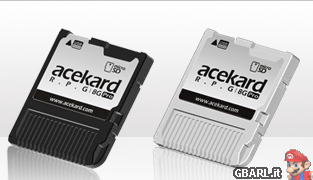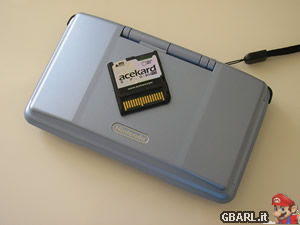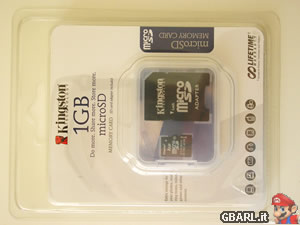Benvenuto Visitatore ( Log In | Registrati )
 Thursday 27 September 2007 - 10:23 Thursday 27 September 2007 - 10:23
Messaggio
#1
|
|
 The Evra Powwah! (Pirla) Gruppo: Veterani Messaggi: 10.824 Iscritto il: Fri 24 December 2004 - 19:38 Da: Nosgoth Utente Nr.: 3.467 Feedback: 0 (0%) |
Quick Links Homepage: www.acekard.com System Updates: GbaRL.it Download Archive Our thanks to Acekard Team and their outlet BambooGaming.com for the sample provided. A long time has passed since the first Slot-1 design was unveiled to scene sites: after the first, awkward attempts, every major manufacturer has opted for this format, releasing more and more perfect units, free of problems and pre-processing steps. Obviously, we've now come to the point where adding new features is extremely difficult, if not impossible. Many of you are already aware of Team Acekard, whose curtain call was a Slot-1 solution, called AceKard+, although its popularity wasn't too high. Now, after 10 months worth of development, they're back, taking the scene by storm with an atypical flashcard: the AceKard R.P.G. Introduction & Features The acronym in the name stands for Real Play Gear, meaning that this product, in the manufacturer's intentions, is aimed towards maximum simplicity for unexperienced users, as well as full flexibility for hackers and more expert developers, with solid support to both games and homebrew code. At the time of this review, the flashcard is not yet available for purchase: the sample we've been given by the AK Team, even though fully completed and stable on the hardware side, is having its packaging still being defined. Those aspects will be further developed through our review. For now, let's take a look at the declared features for this card:
Update - 24/02/2008: we can confirm how those promises have been kept in full. The open-source philosophy, along with the manufacturer's dedication, noticeably lengthened this list. Now AR cheats are fully supported, along with user-created shortcuts, DS-Linux can now take advantage of both data storages and, particularly impressive, the EZ V 3-in-1 is supported straight out of the box, even automatically patching most GBA games. Something we weren't expecting, we have to admit: it's the first time we witness such a powerful system software. On paper, this is a high-end dev kit, easy to use and with special features geared towards hackers and programmers alike. Is that the truth? We'll soon find out. -------------------- Just keep tryin'
Keep on flyin' I will be the light... - from Last Exile: Cloud Age Symphony - Togisumasareta tsume wo hate ima kagayaku tame ni sono kiba wo muke... Shiren wa norikoerarenai hito ni osoikakari wa shinai! - from Megaman X8: Wild Fang - Proud supporter of EVAC Industry co.ltd. |
|
|
|
 |
Risposte
 Thursday 27 September 2007 - 21:45 Thursday 27 September 2007 - 21:45
Messaggio
#2
|
|
 The Evra Powwah! (Pirla) Gruppo: Veterani Messaggi: 10.824 Iscritto il: Fri 24 December 2004 - 19:38 Da: Nosgoth Utente Nr.: 3.467 Feedback: 0 (0%) |
Compatibility and Performance We've now reached the most important part of our review, the one you were awaiting for. Naturally, the question is "ok, cool features, but what about homebrew and games?", and our tests will promptly give an answer. As those who've read our previous articles already know, we utilize a standard set of games, specifically chosen according to their peculiarities or the particular DS hardware they put strain onto. This time, we've updated our list to reflect a few changes Nintendo has made to its game cartridges. Pictured above is our toolkit, made of:
Homebrew No doubt, one of the most interesting uses for a DS flashcard: over the time, an impressive number of homemade software has showed up, turning a simple Nintendo DS into virtually anything, from a (not too) useful kitchen timer to a full-fledged PDA. The R.P.G. includes the now common auto-patching feature: homebrew code will have the relevant DLDI driver applied on the fly, making it easier for programmers and users alike. Here's a detailed report of our findings::
DS Games Here we are, DS games. The following tests were conducted extracting the game from an original cartridge using Rudolph's NDS Backup Tool, then performance data for both media was compared. Here are the results:
Last but not least, a little tale about the team: while we were browsing through the OS, we closed the lid and, upon starting a game, discovered that the audio subsystem had been completely shut down. No speakers' output, no headphones' either. After sending a mail to AK Team, it took them only four hours to get back at us with the explanation, namely a compatibility issue with FlashMe v7, installed on our test unit. We have no doubt the issue will be fixed in the future, neverthless it was a pleasant show of attention towards the end user. Download Play As of firmware version 4.05, Download Play-specific routines have been added: the downside is that they break some games and are therefore presented as a feature to be toggled on beforehand. Neverthless, our tests showed no sign of troubled plays. An award, also, for being the only card, to date, to offer full compatibility with the Wii Linkage featured in PokŔmon Battle Revolution and possibly other Wii titles. -------------------- Just keep tryin'
Keep on flyin' I will be the light... - from Last Exile: Cloud Age Symphony - Togisumasareta tsume wo hate ima kagayaku tame ni sono kiba wo muke... Shiren wa norikoerarenai hito ni osoikakari wa shinai! - from Megaman X8: Wild Fang - Proud supporter of EVAC Industry co.ltd. |
|
|
|
Inserisci in questo messaggio
 Evrain [REVIEW] AceKard R.P.G. - 8G PRO Thursday 27 September 2007 - 10:23
Evrain [REVIEW] AceKard R.P.G. - 8G PRO Thursday 27 September 2007 - 10:23
 Evrain Inside the Box
As usual, the sample reached us c... Thursday 27 September 2007 - 14:17
Evrain Inside the Box
As usual, the sample reached us c... Thursday 27 September 2007 - 14:17
 Evrain Getting Started
After describing the hardware, her... Thursday 27 September 2007 - 19:42
Evrain Getting Started
After describing the hardware, her... Thursday 27 September 2007 - 19:42
 Evrain GUI & System Software
Examining the R.P.G. sy... Thursday 27 September 2007 - 20:15
Evrain GUI & System Software
Examining the R.P.G. sy... Thursday 27 September 2007 - 20:15
 Evrain Final Thoughts
Finally this lengthy review has com... Thursday 27 September 2007 - 21:49
Evrain Final Thoughts
Finally this lengthy review has com... Thursday 27 September 2007 - 21:49  |
1 utenti stanno leggendo questa discussione (1 visitatori e 0 utenti anonimi)
0 utenti:

|
Versione Lo-Fi | Oggi è il: Tue 1 July 2025- 10:32 |
















